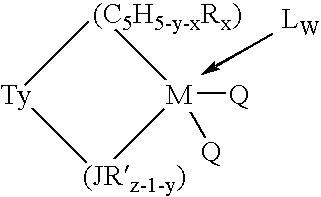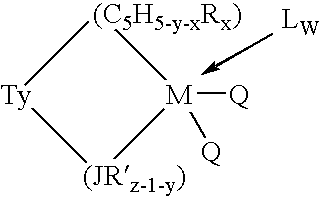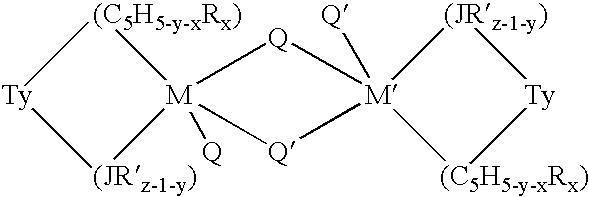Aluminum-free monocyclopentadienyl metallocene catalysts for olefin polymerization
a monocyclopentadienyl metallocene and catalyst technology, applied in the direction of organic compound/hydride/coordination complex catalyst, physical/chemical process catalyst, organic compound/chemical process catalyst, etc., can solve the problem of low catalytic activity of such metallocene catalyst system, low activity of neutral group iii catalyst, and high cos
- Summary
- Abstract
- Description
- Claims
- Application Information
AI Technical Summary
Benefits of technology
Problems solved by technology
Method used
Image
Examples
example 1
[0095]A catalyst solution prepared from 19.7 mg of Me2Si(Me4C5)(N-t-Bu)ZrMe2 and 6 mg of [DMAH] [B(pfp)4] in 20 mls of toluene was added to a 1 liter stainless-steel autoclave containing 400 mls of hexane. The reactor temperature was maintained at 40° C. and stirred vigorously while ethylene was added at 90 psi. After 30 minutes the reaction was stopped giving 30 grams of HDPE after work-up. The GPC analysis showed a bimodal distribution with modes centered at 900,000 and 2,000.
example 2
[0096]A catalyst solution prepared from 28.6 mg of Me2Si(Me4C5)(N-t-Bu)ZrMe2 and 9 mg of [DMAH] [B(pfp)]4 in 20 mls of toluene was added to a 1 liter stainless-steel autoclave containing 400 mls of hexane. The reactor temperature was set at 50° C. and was stirred vigorously while 100 mls of butene and 60 psi of ethylene were added. Following the addition of butene and ethylene, an instantanious increase in temperature to 90° C. was observed. After 30 minutes the reaction was stopped, yielding 130 grams of a waxy ethylene-butene copolymer. GPC analysis showed a bimodal distribution with modes centered at 27,000 and 2,000 in approximately equal ratios. IR spectroscopy showed the presence of butene in the copolymer.
example 3
[0097]A catalyst solution prepared from 40 mg of MePhSi(C5Me4)(N-t-Bu)HfMe2 and 11 mg of [DMAH][]B(pfp)4] in 20 mls of toluene was added to a 1 liter autoclave containing 400 mls of hexane. The reactor temperature was set at 40° C., stirred vigorously and pressurized with ethylene (90 psi) for 15 minutes. The reactor temperature increased from 40 to 97° C. during the polymerization. The reactor was stopped and 98 grams of polyethylene was isolated having a Mw=47.7 K and a MWD=3.0.
PUM
| Property | Measurement | Unit |
|---|---|---|
| temperature | aaaaa | aaaaa |
| molecular weight distribution | aaaaa | aaaaa |
| molecular weight distribution | aaaaa | aaaaa |
Abstract
Description
Claims
Application Information
 Login to View More
Login to View More - R&D
- Intellectual Property
- Life Sciences
- Materials
- Tech Scout
- Unparalleled Data Quality
- Higher Quality Content
- 60% Fewer Hallucinations
Browse by: Latest US Patents, China's latest patents, Technical Efficacy Thesaurus, Application Domain, Technology Topic, Popular Technical Reports.
© 2025 PatSnap. All rights reserved.Legal|Privacy policy|Modern Slavery Act Transparency Statement|Sitemap|About US| Contact US: help@patsnap.com



